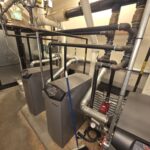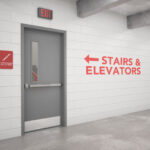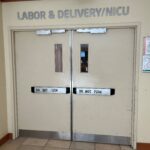I haven’t written much about interlocks on this site because the International Building Code (IBC) doesn’t include requirements for interlocks except for sallyports used in I-3 occupancies (usually detention facilities). NFPA 101 – The Life Safety Code doesn’t address interlocks either. A proposal submitted for the 2021 IBC could change that.
If you’re not familiar with interlocks, I wrote about them back in 2010 – there’s even a video to illustrate how they work. Imagine a vestibule with 2 doors. When someone opens one door of the vestibule, the other door can not be opened until the first door is closed. This operation controls traffic or the transfer of air and contaminants; interlocks are sometimes used in clean rooms, data centers, cash rooms, and other secure environments.
Because of the potential for interlocks to inhibit egress, it’s important for the model codes to include some requirements. Currently, each interlock must be approved by the Authority Having Jurisdiction, but there are no standardized guidelines for what a code official should require when evaluating a proposed interlock.
BHMA has proposed a change to the 2021 IBC, to create some guidelines for interlocks – called “control vestibules” in the proposed code language. At the recent hearings, there was discussion among the technical committee about limiting the use groups where an interlock/control vestibule may be used.
We need your help to get this right! We want to make sure that the code allows control vestibules where they are needed. I have seen them in business, factory, institutional, and storage occupancies. The other IBC use groups are assembly, educational, high-hazard, mercantile, residential, and utility. Do you see a need for control vestibules in these occupancies? Where have you specified/installed control vestibules? WWYD?
And in case you’re curious, here is the current proposed language for the code change:
1010.1.4.6 Control vestibule. Where doors in the means of egress are configured as a control vestibule, the door locking system shall provide for emergency egress. The control vestibule shall comply with all of the following unless otherwise approved.
1. An approved override shall be provided on the egress side of each door of a control vestibule.
2. An approved override shall be provided on the ingress side of the outer door of a control vestibule.
3. Upon activation of the automatic sprinkler system or automatic fire detection system, the interlock function of the door locking system shall deactivate.
4. Upon loss of power to the interlock function of the doors, the interlock function of the door locking system shall deactivate.
5. The egress path from any point shall not pass through more than one control vestibule unless approved by the code official.
6. The door locking system units shall be listed in accordance with UL 294.
~~~
I can’t find a good photo or graphic of an interlock, so if you have one that I can add to this post, send it along!
You need to login or register to bookmark/favorite this content.





I’ve often heard of these doors referred to as ‘man-traps’ before, might just be a Canadian thing.
From what I’ve seen, the intent behind these types of installations is to prevent tailgating and to add a layer of verification to the access control system (typically, after entering the first door, there is an intercom with video which verifies the person’s credentials inside the controlled vestibule prior to allowing them access through the final door).
In terms of the proposed language I’d be more careful with the wording of ‘inner’ & ‘outer’ and maybe use terms such as ‘secured’ vs ‘unsecured’ ; (to me) the language inner/outer can be confusing depending on the direction of travel.
Just to clarify; on fire alarm the interlock function of the doors shall deactivate, but will the individual security of each door also be required to deactivate (default to unlocked)? As it is currently stated, I’d assume that the individual function of the doors will remain unaffected.
I have seen interlocks designed into a shooting range or two. Possibly to control traffic in/out of the live range, and/or possibly to help keep gunsmoke and lead out of the rest of the building. Shooting ranges would be high-hazard occupancy, correct?
Shooting range I think is not in the category of high hazard occupancy. I think it could be classified in A-3 (Assembly) occupancy.
1. An approved override shall be provided on the egress side of each door of a control vestibule.
2. An approved override shall be provided on the ingress side of the outer door of a control vestibule.
Does not say who gets to control the override.
Should state some how what is an approved override, is it some clerk pushing the buzzer??
I have seen them mainly at the cash stores, but each side has their own exit to leave out of. Not sure I would vote for this for any assembly except a jail setting?
Not sure why they are trying to get the language in??
Can you publish some of the justification for the code?
Will a set up fit under UL 294???
I could see allowing something, but not as at an exit or in the exit access. A door other than an exit door, as there is the normal exiting, if you want to get out of an area/ room.
The business requires all or certain people to enter or exit through this door, for control or counting or whatever, but it is not a required exit.
Seems like there is enough in the code, to get what people want, without adding more to it.
An image of “Interlocking System A” can be found on the website of Security Door Controls at the link, also click on pdf symbol for riser and wiring diagrams.
http://www.sdcsecurity.com/interlocking-system-a.htm
None of these would work in a detention facility. As soon as they knew the alarm system would disable the door, they would be running for the doors…
I agree – detention has its own rules. This is more for clean rooms and similar where you’re just trying to control traffic and airflow.
– Lori
Into what usage category would something like a live exotic butterfly exhibit be placed?
One question, one concern with comments. What is considered and “approved” override? Certain H occupancies will require additional controls. If a fire occurs in a bio-hazard area, releasing all controls could do more harm than good. There is nothing in the above about coordination with other, perhaps more critical, systems except fire and sprinkler.
I have no objection to the new guidelines, but what constiturptes an “approved” over ride device? Does a card reader qualify?
Also if the interlock requires a UL Listing as a system, do the maglock sand interlock controller all need to come from the same manufacturer?We use many many many M490 maglock, hopefully Allegion will come up with their own UL Listed interlock controller.
Into what usage category would something like a live exotic butterfly exhibit be placed?
Probably an assembly
Depending on the set up
IBC needs to identify which occupancies this is acceptable in. I would assume it would not be allowed in Assembly or Hazardous occupancies?
Hi Casey –
That was the question the post was asking – which occupancy types should allow this application.
– Lori